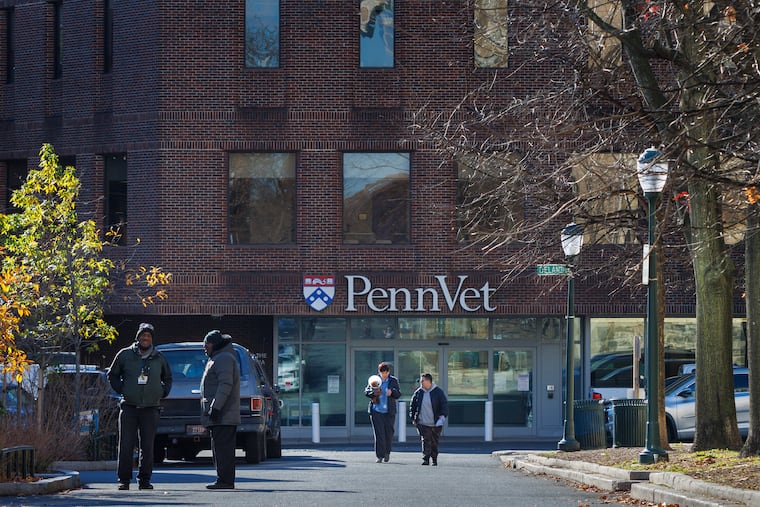Penn Vet students say they’re working 100-hour weeks and patient care is suffering
Scores of current students and recent graduates say that Penn Vet sees them more as an unpaid labor pool to tap than students who are paying more than $60,000 a year to be educated.

One day earlier this fall, a fourth-year Penn Veterinary Medicine student arrived for her shift at the school’s Ryan Veterinary Hospital at 6 a.m. and stayed until it ended, nearly 12 hours later.
She left to walk her dog and attend a virtual meeting of students and administrators, a rare break she considered a luxury, then returned to the University City hospital to work her five-hour “treatment shift,” where she performed nursing duties — walking dogs, giving animals medications, cleaning their kennels. At midnight, when her shift ended, she left. Then she geared up to arrive back at the hospital the next day at 6 a.m.
It’s the kind of schedule that she and her classmates have come to expect in their clinical year at Penn Vet, the final year of education when students work in the hospital largely without pay. And it’s made many of them feel as if the school sees them more as an unpaid labor pool to tap than students who are paying more than $60,000 a year to be educated.
At the virtual meeting with administrators in October, students aired their concerns to the school’s administrators.
“I just don’t see how getting four hours of sleep tonight is necessary or beneficial to my education at all,” the student said, according to a recording The Inquirer obtained.
Penn Vet bills itself as “one of the world’s premier veterinary schools.” It ranks fifth among vet schools in the country and is one of two vet schools affiliated with an Ivy League university. It touts that it’s the only vet program to emerge out of a medical school.
But scores of current students and recent graduates say that their clinical schedules are unsustainable and get in the way of not only their education but also their ability to treat patients effectively.
In a letter to administration signed by 65 fourth-year students and recent graduates, students said they were consistently working more than 100 hours a week — a violation of guidelines from the Student American Veterinary Medical Association (SAVMA), which calls for a cap of 80 hours a week. (SAVMA does not have any authority to enforce its guidelines; it only encourages institutions to follow them.) Forty-seven students signed the letter with their names.
“Penn and Drexel medical schools have strictly capped student work hours at 80 per week, and we believe that Penn Vet needs to follow suit to protect their students and patients,” they wrote in the August letter, adding that students should not have to “cover nursing shifts to make up for staffing shortages.”
And because students rely on faculty and residents for recommendation letters, they say that makes it all the more difficult to advocate for breaks during long shifts or lighter work loads.
» READ MORE: Some Pa. senators say they won’t approve more than $31 million in state funding for Penn Vet until Liz Magill resigns
Penn Vet has “recently implemented changes across our small-animal and large-animal hospitals to reduce or alleviate student work load concerns while ensuring that our students get the hands-on, meaningful education that they need, and our efforts continue,” spokesperson Martin Hackett said in a statement.
He declined to elaborate on the changes but said the school was hosting quarterly check-ins with students in December to discuss them.
“We understand the importance of maintaining an open line of communication to address these concerns — and we appreciate the feedback that we have received,” he said.
Hackett declined to make the school’s dean, Andrew M. Hoffman, available for comment.
Vet nursing shortage is ‘incredibly real’
Five current and former Penn Vet students, all of whom requested anonymity for fear that retaliation could hamper future employment, expressed in interviews the feeling that the school did not care about their well-being and that students were expected to help keep the hospital running at the expense of their education.
“It often felt like we were being required to do [treatment shifts] because the hospital didn’t want to hire more staff,” one recent graduate said, describing how much of those shifts involved such duties as cleaning litter boxes and taking vitals of the animals.
In the October meeting, when students asked administrators why they were being called in to cover nursing shifts, Brady Beale, chief medical officer of Ryan Veterinary Hospital, said the hospital was not dealing with a nursing shortage.
“We’ve just been hit with an unusual, a really, really unusual number of illnesses and injuries,” she said on the recording.
But she added: “We have to acknowledge that we’re in a highly unusual place in veterinary medicine right now. The veterinarian and veterinary technician shortage is incredibly real.” (Veterinary technician and nurse are terms that are used interchangeably.)
These issues are not exclusive to Penn. At Iowa State University, another top-ranked vet school, students said that they regularly worked more than 80 hours a week, violating the school’s own policy, and that some rotations were so taxing there was no time to eat lunch.
Penn medical residents voted to unionize last May, citing grueling work hours in an environment in which taking breaks was seen as a sign of weakness. They were some of the thousands of medical residents who have unionized across the country in the last year.
Since Penn Vet students are not employees, they cannot legally unionize.
As the students put in their letter: “[We] are left with no recourse but to raise our concerns with the administration, which hopefully will lead to the changes we are looking for.”